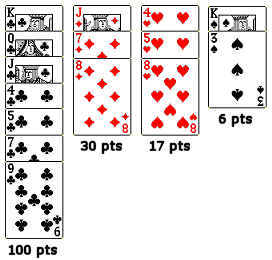| Expedition An Adaptation of Lost Cities |
More about Me
Favorite Links
Paramecium Info
Role Playing Games
Harry Potter CCG
Card and Dice Games
Piggy Six Dice Game
Ghost Stories
My Wacky Dreams
Are Aliens Watching
Fishes for Beginners
Original Poem
The Pink Elephant
Men in Black Episodes
Unbiased Truths
Future Activities
Email Me
Expedition
A 2-player game using one 52-card deck. Ace through 10 are "Expedition Cards". Each suit is a different "Expedition". Face cards are "Multiplier Cards".
Shuffle the cards and deal 7 to each player face down. Place the remaining cards face down near the board as the draw pile.
Play
On his turn a player must first play one card from his hand (by either
adding a card to one of four expeditions or discarding a card), and then
must draw a card to replace it (either from the top of the draw pile or
the top of the discard pile).
Add a card to an expedition
The player can start a new expedition or add to an expedition already
begun. To start a new expedition, the player simply places a card from
that expedition face up in front of him. To add to an expedition, the
player places a new card from the same suit so that it partially covers
the previous card from that expedition. The cards must always be added to
the top of the expedition and with increasingly higher numbers. The
numbers do not need to be consecutive, any higher number is permitted. The
cards of an expedition are placed so that the values of all can be seen by
both players. For example, the 4 of clubs can be played over the 2 of
clubs, but not over the 7 of clubs.
Multiplier Cards
For each expedition there are 3 multiplier cards (the Jack, Queen, and
King). These may only be played at the beginning of an expedition (before
any numbered cards are played to that expedition) and multiply the value
of that expedition. Any number of these cards may be played in any order
before the first numbered card of an expedition. Once a numbered card has
been played to an expedition, further multiplier cards are not allowed for
that expedition.
Discarding a card
The player can discard a card instead of adding to an expedition. To
discard a card, the player places the card face up in the discard pile.
Draw a card
The player draws a card and adds it to his hand. He may either take the
top card from the face down draw pile or the top card from the discard
pile. The player may not draw the same card he discarded on this turn.
Game end and scoring
The game ends when a player takes the last card of the draw pile. Players
are allowed to count the cards remaining in the draw pile to better plan
their plays.
Then the players calculate their scores. Each expedition is scored separately. The numbered cards in the expedition are added together. The value of each expedition is then multiplied by the number of investment cards that player played for that expedition plus 1. Thus, the multiplier will be 2, 3, or 4, if the number of investment cards is 1, 2, or 3, respectively. See the illustration below for an example of scoring.

In addition, each expedition which contains at least eight cards (multiplier cards and numbered expedition cards), earns a fixed bonus of 20 points, after the multiplier.
One player records the scores on paper, adding scores from the current round to those from previous rounds. All cards are shuffled for another round of play. The player with the most total points so far in the game begins play for the next round.
After the agreed number of rounds, usually three, the game ends. The player with the most total points is the winner.
Work consists of whatever a body is obliged to do. Play consists of whatever a body is not obliged to do.
--Mark Twain